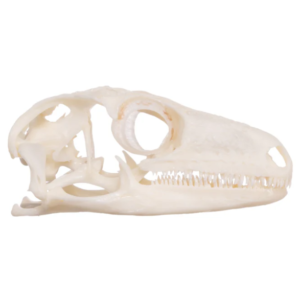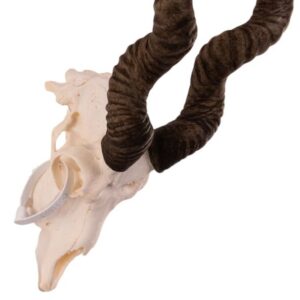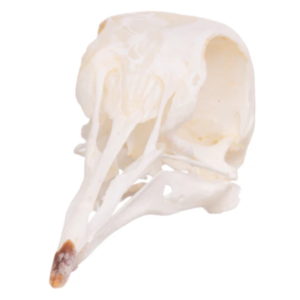Description
Real Finch Skull For Sale
Explore the intricate anatomy of a Real Finch Skull For Sale. Learn about its unique features, evolution, and how it contributes to their feeding habits.
Specifications:
- Species unknown
- The photos shown are examples of what your specimen will approximately look like. Each finch skull is unique and will vary in size, shape, color, etc.
- Average Skull Length 2.3 cm (0.9 in.)
- Average Skull Width 1.3 cm (0.5 in.)
- Average Skull Height 1 cm (0.4 in.)
The Finch Skull: A Tiny Window into Evolution
The humble finch, a bird often overlooked, holds a remarkable key to understanding the power of natural selection. And at the heart of their evolutionary story lies a surprisingly informative structure: the finch skull. This delicate, bony framework, housing a brain barely larger than a pea, has provided invaluable insights into how species adapt and diversify in response to environmental pressures.
The story of the finch skull is inextricably linked to the Galapagos Islands, a remote archipelago where Charles Darwin made some of his most crucial observations. Darwin noticed that the finches on these islands, though similar in other respects, possessed beaks of vastly different shapes and sizes. He hypothesized, correctly, that these variations were driven by the availability of different food sources.
Decoding the Beak: A Skull-Deep Connection
The shape of a finch’s beak is not just a superficial feature. It’s intimately connected to the underlying structure of the skull. The bones of the maxilla (upper jaw) and mandible (lower jaw), along with their associated muscles, determine the strength and precision with which a finch can crack seeds, probe for insects, or sip nectar.
Scientists have meticulously studied the skulls of Galapagos finches, using techniques ranging from traditional anatomical measurements to sophisticated 3D imaging and genetic analysis. These studies have revealed a clear correlation between beak morphology and diet.
- Large, blunt beaks are ideal for cracking tough seeds, like those found on islands with abundant hard-shelled nuts.
- Long, pointed beaks are perfect for probing flowers for nectar or reaching insects hidden in crevices.
- Smaller, delicate beaks are well-suited for picking up small insects or soft fruits.
Evolution in Action: A Living Laboratory
The Galapagos finches, and their telltale skulls, provide a compelling example of natural selection in action. When food resources are abundant and diverse, finches with a wider range of beak shapes can thrive. However, during periods of drought or other environmental changes, the finches with beaks best adapted to the available food are more likely to survive and reproduce, passing on their advantageous traits to their offspring.
This process of natural selection has led to the diversification of the finch family into a remarkable array of species, each uniquely adapted to its specific niche in the Galapagos ecosystem. By studying the finch skull, scientists can reconstruct the evolutionary history of these birds and understand how they have adapted to the challenges of their environment.
Beyond the Galapagos: Universal Principles
The lessons learned from the finch skull extend far beyond the Galapagos Islands. They provide a powerful illustration of how natural selection can shape the morphology of organisms in response to environmental pressures. This principle applies to countless other species, from insects to mammals, and helps us understand the incredible diversity of life on Earth.
A Continuing Saga of Discovery
Research on the finch skull continues to this day, with scientists exploring the genetic and developmental mechanisms that control beak development. They are also investigating the role of hybridization and gene flow in the evolution of finch beak shapes.
The tiny finch skull, a seemingly insignificant bone structure, has become a powerful symbol of evolutionary biology. It reminds us that even the smallest details of an organism’s anatomy can hold profound clues about the history and future of life on our planet. By continuing to study these remarkable birds and their fascinating skulls, we can gain a deeper understanding of the processes that have shaped the world around us.











Reviews
There are no reviews yet.